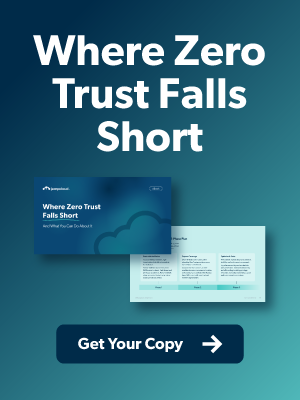Updated on October 2, 2025
Passwordless authentication is a priority for enterprise IT going into 2026, with the market projected to grow from USD 18.36 billion in 2024 to USD 86.35 billion by 2033, as 61% of organizations plan to transition to passwordless solutions this year. This guide benchmarks the top five enterprise-ready solutions—JumpCloud Go™, Okta Identity Engine, Microsoft Entra ID passwordless, HYPR, and Ping Identity—against critical capabilities for large enterprises, using JumpCloud as the benchmark for comparison.
How we selected and ranked the tools
We evaluated each platform using an objective, enterprise-first methodology based on zero-trust principles: verify explicitly, enforce least privilege, and assume breach. Our analysis included hands-on testing, vendor documentation, and outcomes from large-scale deployments across hybrid and multi-cloud environments. Tools were ranked on:
- Security depth: FIDO2/WebAuthn adoption, resistance to credential stuffing and replay attacks.
- Operational scalability: Performance beyond 100,000 users and multi-region deployments.
- Integration breadth: Native connectors for major identity sources and SaaS applications.
- Admin overhead: Console clarity and policy automation.
- Total cost of ownership: Transparent licensing and potential ROI.
Evaluation criteria
- Security posture: Depth of phishing-resistant authentication, biometric liveness detection.
- Scalability: Support for >100,000 users without degraded performance.
- User experience: Frictionless login flows and support for device-native authenticators.
- Integration breadth: Native connectors for AD, Azure AD, HRIS, and major SaaS apps.
- Management overhead: Policy automation, reporting depth, and delegated administration.
- Total cost of ownership: Transparent per-user licensing and implementation costs.
Scoring methodology
We applied a weighted scoring model reflecting enterprise risk and operational priorities:
| Criterion | Weight |
|---|---|
| Security | 30% |
| Scalability | 25% |
| User experience (UX) | 20% |
| Integration breadth | 15% |
| Total cost of ownership (TCO) | 10% |
Security and scalability carry the highest weight due to their impact on enterprise risk and operational continuity.
#1 JumpCloud Go™ Passwordless Authentication
JumpCloud is a market leader with its open directory platform, serving over 250,000 organizations worldwide. Its passwordless authentication integrates identity, device, and access management for streamlined enterprise rollout.
Core capabilities
- Biometric login – Supports facial recognition and fingerprint verification across multiple platforms.
- Device trust – Conditional access for enrolled, compliant devices.
- Passkeys – FIDO2/WebAuthn-compatible credentials for phishing-resistant authentication.
- MFA fallback – Hardware tokens or OTP for access continuity.
- Zero-trust policy engine – Adjusts access based on user and device posture.
Enterprise benefits
- Reduce help-desk tickets for authentication issues.
- Cut password-related support costs.
- Accelerate onboarding from days to minutes.
- Supports Windows, macOS, and Linux, ensuring that a single solution can manage and secure a diverse fleet of devices.
- Provides comprehensive audit logs and reports, making it easier for organizations to demonstrate compliance with a variety of regulations, including SOC 2, HIPAA, and GDPR.
Integration and deployment
- Plan: Map user populations to dynamic policies.
- Configure: Enable JumpCloud Go™ and define access rules.
- Roll out: Use zero-touch device enrollment for configuration.
For complex deployments, JumpCloud Professional Services can assist.
#2 Okta Identity Engine
Okta is an IDaaS platform with extensive enterprise integrations and a strong IAM market position.
Core capabilities
- Adaptive MFA – Risk-based prompts informed by user behavior.
- Universal Directory – Normalizes identities from AD, LDAP, and SaaS sources.
- Lifecycle automation – HRIS-triggered access workflows.
- Passwordless options – WebAuthn passkeys and biometric prompts.
Enterprise benefits
- Improved security with contextual authentication.
- Streamlined provisioning reduces admin effort.
- Compliance readiness with pre-built templates for SOC 2, HIPAA, and GDPR.
Integration and deployment
- Connector library: 7,000+ pre-built integrations.
- APIs: Rich REST APIs for custom workflows.
- Deployment model: Cloud-native SaaS with optional hybrid support.
#3 Microsoft Entra ID Passwordless
Microsoft’s passwordless strategy integrates seamlessly with Windows, Azure, and Microsoft 365, enhancing user experience.
Core capabilities
- Windows Hello – OS-level facial or fingerprint authentication.
- Passwordless FIDO2 keys – Support for YubiKey and Microsoft-compatible security keys.
- Seamless SSO – Automatic access to Azure and Microsoft 365.
- Conditional Access – Policies based on device compliance and risk signals.
Enterprise benefits
- Consistent user experience across Microsoft services.
- Reduced attack surface with FIDO2/WebAuthn.
- Global scalability with multi-region support.
Integration and deployment
- Hybrid AD sync – Azure AD Connect enables staged coexistence.
- Policy as code – Automated enforcement and drift detection.
- Migration path: Microsoft’s guide supports phased transitions.
#4 HYPR
HYPR offers hardware-backed, FIDO2-first authentication for high-security environments.
Core capabilities
- Passwordless hardware tokens – Support for Bluetooth, NFC, and USB-C keys.
- Biometric-ready – Optional device biometrics for local verification.
- Zero-knowledge architecture – No shared secrets stored server-side.
- Dynamic risk engine – Real-time context detection for step-up policies.
Enterprise benefits
- Compliance with NIST 800-63B and FIDO2 certifications.
- Lower phishing risk with public-key cryptography.
- Predictable licensing with flat per-user pricing.
Integration and deployment
- SDKs: Native SDKs for iOS, Android, and Web.
- Directory connectors: Integrations for AD, Azure AD, and JumpCloud.
- Phased rollout: Start with high-risk users, then expand.
#5 Ping Identity
Ping Identity provides capabilities for hybrid and multi-cloud enterprises, including data residency controls.
Core capabilities
- PingOne Passwordless – WebAuthn passkeys and biometric verification.
- Identity federation – SAML, OIDC, and OAuth for SSO across apps.
- Adaptive authentication – AI-driven risk scoring.
- Enterprise-grade MFA – OTP, push notifications, and hardware tokens.
Enterprise benefits
- Improved productivity with one-tap access.
- Reduced credential fatigue with consolidated MFA prompts.
- Compliance coverage for PCI-DSS, FedRAMP, and GDPR.
Integration and deployment
- Pre-built connectors: Integrations for SAP, ServiceNow, and Salesforce.
- Hybrid deployment: SaaS or on-premises for data residency.
- Automation: Terraform modules for infrastructure provisioning.
Frequently Asked Questions
How long does a passwordless rollout take?
Typically, 8–12 weeks, including pilot, policy definition, and user migration.
What if a user loses their biometric device or hardware token?
Administrators can issue a one-time passcode while revoking the lost credential.
Can passwordless integrate with existing directories like AD or JumpCloud?
Yes, most solutions support SCIM or LDAP connectors for synchronization.
How does passwordless support compliance requirements (SOC 2, GDPR, HIPAA)?
Platforms generate immutable logs, enforce encryption, and provide audit mappings.
What are the typical cost models for enterprise passwordless solutions?
Most vendors offer per-user subscription pricing, often $5–15 USD monthly, plus optional implementation fees.
How do I manage multi-platform device support with a passwordless strategy?
Choose a platform with native support across major operating systems and consistent policy enforcement.
What backup or recovery methods are recommended?
Implement secondary factors, maintain encrypted recovery keys, and regularly test recovery protocols.






